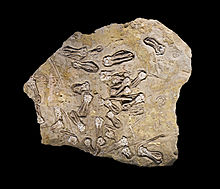
25°02′42″S 115°07′52″E / 25.045°S 115.131°E / -25.045; 115.131 (Jimba Jimba) Jimba Jimba Station, most often referred to as Jimba Jimba, is a pastoral lease currently operating as a cattle station in Western Australia, that once operated as a sheep station.
The property is situated near Gascoyne Junction, approximately 150 kilometres (93 mi) east of Carnarvon and 310 kilometres (190 mi) north of Kalbarri. The property has double frontage to an approximately 50-kilometre (31 mi) length of the Gascoyne River, and backs onto the Kennedy Range in the Gascoyne region of Western Australia.
Description
The station was established in 1878 by G. Hamersley and S. Simms and occupied an area of 100,000 acres (40,469 ha). By 1885, the station had changed hands and was owned by Samuel James Phillips and his brother John H. Phillips.
Jimba Jimba was severely flooded along with surrounding properties including Erivilla and Clifton Downs in 1896 following heavy rains. The Gascoyne River and many of its tributaries broke their banks resulting in loss of stock.
By 1906 Messrs S. J. Phillips and Company owned Jimba Jimba and a total of 23,000 sheep were shorn producing 290 bales of wool.
Philip Ryan managed the station until 1907, when Douglas Philips, John Phillip's son, took over management of the property. In 1911 the property had a good shearing season with 400 bales of wool produced. Following the deaths of John and Samuel Philips the property passed onto Douglas in 1921. In 1926 approximately 19,000 sheep were shorn yielding 475 bales of wool.
A team of eight shearers led by Bill Young sheared 8,205 sheep in a 38½ hour week in 1954 at Jimba Jimba.
A seven-year drought was broken in 2010 when the area received its wettest day on record. This triggered massive flooding along the Gascoyne River, with water levels up to 17 metres (56 ft) above normal. Floodwaters almost surrounded the homestead, with people having to be winched from rooftops by a police helicopter.
Geology

The station gave name to the Early Permian Jimba Jimba Formation, part of the Wooramel Group. In the limestones of the formation, many fossil bivalves, gastropods and brachiopods have been found. The crinoid Jimbacrinus bostocki, found in sandstones of the Cundlego Formation, was also named after the station.
See also
References
- ^ "Rural Farm For Sale, Carnarvon Western Australia". No Agent Property. 2013. Retrieved 21 September 2013.
- ^ "Jimba Jimba Station". Heritage Council of WA. 4 September 2012. Retrieved 22 September 2013.
- "Floods on the Gascoyne". The Inquirer & Commercial News. Perth. 27 March 1896. p. 9. Retrieved 21 September 2013 – via National Library of Australia.
- "Dalgety & Co's report". The Northern Times. Carnarvon, Western Australia. 6 October 1906. p. 2. Retrieved 22 September 2013 – via National Library of Australia.
- "Jimba Jimba". The Northern Times. Carnarvon, Western Australia. 30 September 1911. p. 3. Retrieved 22 September 2013 – via National Library of Australia.
- "Jimba Jimba". The Northern Times. Carnarvon, Western Australia. 13 August 1926. p. 7. Retrieved 23 September 2013 – via National Library of Australia.
- "Click go the shears—fast!". The Argus. Melbourne, Victoria. 30 June 1954. p. 3. Retrieved 22 September 2013 – via National Library of Australia.
- Jane Kennedy (19 December 2011). "The Gascoyne floods one year on". Australian Broadcasting Corporation. Retrieved 23 September 2013.
- Nicholas Perpitch (20 December 2010). "Rescue in Western Australia as flood records rewritten". The Australian. Retrieved 23 September 2013.
- BMR WO3, Jimba Jimba Station at Fossilworks.org
- Jimbacrinus at Fossilworks.org
| Stations in the Gascoyne region of Western Australia | |
|---|---|